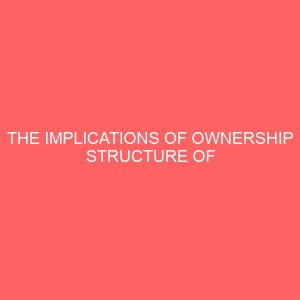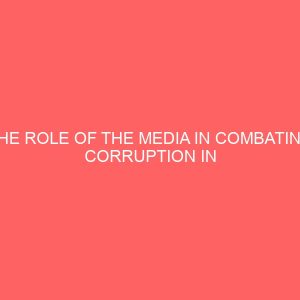Description
ABSTRACT
The aim of this research is to look at and asses the strategies of production planning and inventory control in the hospitality industry. This research work stated with a background on production planning and inventory control strategies. Then the research tried to establish an understanding of production planning and inventory control. And the emphasis of this research in on Nike Lake Resort enugu, Enugu State. Furthermore, the rationale for the research was highlighted. In addition works be different authors were consulted and the authors duly acknowledged. The research covers a population of 300 and sample of 50. Questionnaire were administered to all respondents which they all responded. For the research to have meaning, hypothesis were developed and tested. The hypotheses developed are;
CHAPTER ONE
1.0 INTRODUCTION
Advertising was derived from the Latin word ad vertere which means to turn the mind toward. Advertising is a major tool in the marketing of products, services and ideas. The idea is to sell products, services or ideas to consumers. The companies certainly think it is a good method of selling, and have increased their advertising year after year Taflinger, 1996.
It is a form of communication used to encourage, persuade, or manipulate an audience viewers, readers or listeners; sometimes a specific group to continue or take some new action. Most commonly, the desired result is to drive consumer behavior with respect to a commercial offering. Advertisement can also be used as a means of reassuring employees or shareholders that a company is viable or successful. Advertisement messages are usually paid for by sponsors and viewed via various transmission media such as newspaper, magazines, television commercial, radio advertisement, outdoor advertisement or direct mail; or new media such as blogs, websites or text messages.
Information and Communication Technology is perceived to be a force to be reckoned with in the 21st century because it has caused and continues to cause major changes in the way we live. As far as the digital age is concerned, the benefits accrue from ICT is enormous. One of the sectors that has benefited immensely from the use of ICT is the broadcast industry. With the use of ICT, creating awareness is immediate, timely, and helps reduce the space constraints: the death of distance.
The use of Information Communication Technology ICT has become more integrated into most aspects of life including advertising. ICT means all forms of media used to handle and convey messages about a product or service to the consumers. ICT based ads continues to gain an edge over other noncomputerized advertising materials such as brochures, posters or billboards because of advantages it has in promotional messaging Somuyiwa, 2010.
1.1 BACKGROUND OF THE STUDY
Advertising as a concept, can be defined as a form of communication through the media about product, services, ideas, personalities or organizations, paid for by an identified sponsor Alide in Okunna 2002: 99.
Bovee and Arens 1985 gave a more widely accepted definition of advertising as the nonpersonal communication of information, usually paid for any usually persuasive in nature about products goods and services or ideas by an identified sponsor through various media. It is an exciting, dynamic, and challenging enterprise.
Its often a persuasive communication in that it tries to persuade the reader, the listener or the viewer to take to the sponsors own point of view and also to take some appropriate action. It is not personal or face to face communication, rather it is directed to a group of people.
Advertising is also controlled, identifiable information and persuasion by means of mass communication media. Defined by Wrignt and Zeight 1982:10. Gillran Dyer says that in its simplest sense, the word advertising means drawing attention to something or notifying or informing somebody of something.
According to the understanding of advertising practitioners council of Nigeria APCON advertising is a form of communication through the media about products, services or ideas, paid for by an identified sponsor.
The terms advertising was coined from the Latin word advertere which mean literally means to draw attention. This is when you are getting the evidence mind in a product, notifying or informing somebody/people of something.
Some of the Popular Advertising Media
Radio
Television
Newspaper
Magazine
ICT GSM, Social Media, blog, website, youtube, digital banner e.t.c
The computer is at the very heart of the convergence and its entry into the media industry has been a credible boom in terms of speed, innovation and accuracy, Ikpe and Ibekwe 2006. They believed that the computer earned this enviable position in the digital convergence because of its ability to transform text, number, sound and graphics into a digital form. The application if ICTs to the media industry has changed the working of the industry, it has influenced broadcast product content, circulation aesthetics and the quality of staff in each ICT driven establishment and created a new set of new carrier. The strategy has also brought people of different profession together. Like those in computer science, electronic engineering etc. In what Nwosu 2007:11 called Synergistic communication for development, where professionals from various fields poll ideas and resources together towards achieving a sustainable human development.
Journalism in the 21st century is an amalgam of training competence and expertise. It requires the sagacity of appreciating audience new and the ability to meet customers aspiration for prosperity a shine on journalist Owuamalam 2006:125. It is only when journalist are abreast with technologies of the 21st century that journalism will be hailed as relevance to the need and service of the society. Journalist must note that at the punch of technology drivers communication button, one is ushered into the information super highway where the desired information about the world is at ones palm. They must discover appropriate use for each new technology to note that laptop computers, GSM handset and even video phones are useless if not put to appropriate use Owuamalam 2006:122.
ICTs have aided in every aspect of mass communication in Nigeria, advertising has survived through the years of early press to the modern times with increasing modernizations as a result of advancement in information and communication technology ICTs Obasi 2011:205
Since ICTs have made it possible for individual who may reside as far off north. Say America assess the details of issues that go on in America, say Nigeria just as it is happening Owualamam 2006:177.
1.2Statement of research problem
According to an industry source MMS 2009, Total Advertising expenditure in Nigeria for 2009 stands at over 400 million, with digital media accruing less than 1 of this spend. Despite huge leaps in ad spend and mobile operators in Nigeria, digital media spend was still negligible compared to other mediums. If these are true, can we continue to do just what we did in the past and expect a different result
ICT in advertising requires customers to use newer technologies; hence, lowspeed internet connection has become a major issue in modern day advertising in Nigeria. Also, if companies build large or complicated websites, individuals connected to the Internet via dialup connections or mobile devices experience significant delays in content delivery.
Furthermore, lack of trust, absence of physical interaction and fear of being deceived and duped have been some of the challenges facing internet or information and communication technology all over the world especially in Africa and Nigeria in particular because it is relatively new to them. To this end, the research seek to determine the influence of information and communication technology which encompasses mobile phone, internet, world wide web www, social networking, blog, and many more on advertisement practice in Nigeria with an evaluation of selected media houses in Plateau state.
1.3 Objectives of the study
Some observers believe that the challenge faced by conventional media has to do with the perfect storm of the global economic crisis, dwindling readership and advertising money, and the inability of newspapers and electronic media to monetize their online efforts Yap, 2009.
The ability of the industry to adjust to current technologies and to gradually switch from the traditional media practices to current trends; opportunities and challenges posed by Information and Communication Technology also raises a lot of issues.
The general objectives of this study include the following;
1.To ascertain the impact of Information and Communication Technology ICT on broadcast media advertising in Nigeria.
2.To investigate the constraints to the use of Information and Communication Technology in broadcast media advertising in Nigeria.
3.To identify the various ways ICT enhances broadcast media advertising in Nigeria.
1.4 SIGNIFICANCE OF THE STUDY
In the past few decades Information and Communication Technology has transformed the world in all spheres of life. Its potential for reducing manual operations and fostering growth in the media has increased rapidly. To strengthen this assertion, Adigwe 2010 cited Okoye 2000 noted that computer technology has enhanced news processing, reporting and media marketing efforts. With the Internet, journalist can now click on relevant sites to source for foreign or even local news for subsequent broadcast news. Indeed, the importance of information and communication technology as a tool for news processing cannot be overemphasized.
Hence this research will look into the various problems and prospects involved in the use of ICT in news broadcasting and advertisement. It will be of great benefit to Broadcasting Houses, Journalists, students of mass communication and the general public as it exposes them to the possibilities that abound in the use of ICT in media broadcasting. Furthermore, this study will go a long way in contributing to knowledge and to the limited literature available in this area of study.








Reviews
There are no reviews yet.